REMEMBERING LILY NG
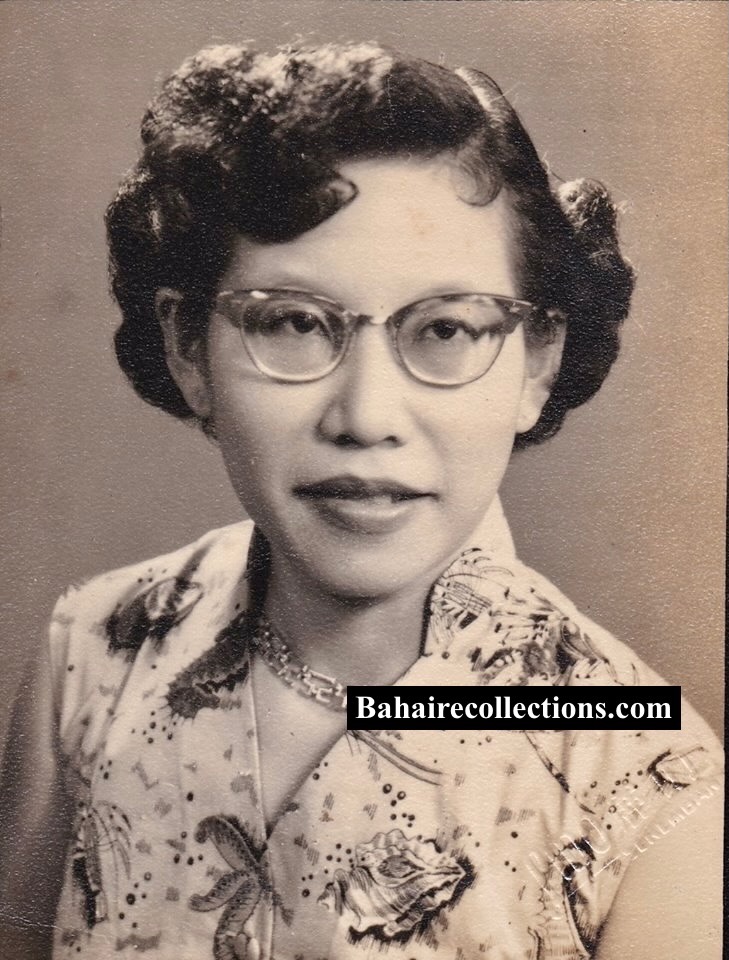
26 December 1926 to 30 May 2025
The Spiritual Assembly of the Bahá’ís of Malaysia
Dear Bahá’í Friends,
The Universal House of Justice was sorry to learn from your letter dated 14 Núr 182 (17 June 2025) and its enclosures of the passing of Lily Ng, sister of Theresa Chee, who were both veteran members of your community. Lily’s devoted services, rendered over many decades, including as a teacher of the Faith, a pioneer to Singapore and Hong Kong, and a member of the National Spiritual Assembly of Singapore, are recalled with appreciation. Kindly convey to her family members and other loved ones the sincere condolences of the House of Justice and assure them of its supplications at the Sacred Threshold for the advancement of her radiant soul in the divine realms and for the comfort and solace of their hearts at this time of bereavement.
Department of the Secretariat
THE UNIVERSAL HOUSE OF JUSTICE
20 June, 2025
The very remembrance of Madam Lily Yan Geok Choo, affectionately called Lily Ng of the Seremban community, would evoke feelings of immense pride, for she had served the Cause with such a driving force and dynamism seldom witnessed in many peers of her time and age. She passed away on 30 May 2025 at the age of 99 leaving a big vacuum that is not bound to be filled for ages to come. Hers has been the passing of yet another staunch and indefatigable worker whose devoted and self-sacrificing services shall never be dimmed in our history. She belonged to the Ten-Year Crusade period and came into the Faith at a time when so much had to be done in the then Malaya to win the remaining goals of the Ten-Year Crusade. With her passing, the community of the Greatest Name has lost one of the veterans, whose exemplary services for the Faith, spanning over 65 years have set examples for generations to come to emulate with every pride. Seldom have Bahá’í women of the early days attained such heights of service as did Lily Ng. She was one of those early women to have led the way for the later generations to follow, at a time when Bahá’í women seldom came out to the open to serve alongside men.
Mrs. Lily Ng, second daughter of Yankee Leong was working as a stenographer in the Drainage and Irrigation Department of the Government of the state of Negeri Sembilan. Even as a non-believer she too took down notes whenever Bahá’í speakers gave talks, including talks by her father Yankee Leong himself. In the course of taking down the notes, she came to get a glimpse of the teachings of Bahá’u’lláh, but not convinced as yet as she was steeped deep into staunch Christianity. Her eldest sister Theresa Chee living in Alor Setar, had accepted the Faith on 13 August 1960 at a summer School in Port Dickson town. Theresa Chee was a devout Catholic and was being trained to become a nun. Theresa herself was training the children at ages & and 9 from the Christian families to become firm believers in Christianity. This was most shocking to the younger sisters of Theresa.
HER DAY CAME
On learning of this, the other sisters Lily Ng- Christie, Rose Ong and Pauline Yan were stunned as they were every strong Catholics. Although Yankee Leong persuaded Lily to accept the Faith, it was Leong Tat Chee of Malacca who was instrumental in she and her sister Christie accepting the Faith on October 26, 1960 in Seremban. Lily Ng had great love for Leong Tat Chee. Although she had heard of the Faith from her father, it was encounters with Leong Tat Chee that ultimately made her accept the Faith. She says, “On the evening of 25 October 1960 day, I went to the Bahá’í Centre at Rahang Road, Seremban. When I arrived, there was Leong Tat Chee with a wide smile on his face and he said, “Oh it’s so pleasant to see you; you have come at the right time. Come, sit down and let me say a few words about becoming a Bahá’í.” He then related to me the truth of Bahá’u’lláh’s message, and before I could reply he went to get a Bahá’í declaration card. I told him, “Uncle Leong Tat Chee, later please.” It was not that I didn’t want to accept and be a Bahá’í but I said to myself, “Such an important step to take must be done on my own accord and with no one asking me to be a Bahá’í.” Nevertheless, the very next evening I went to the Bahá’í Centre, sat down and told my father, “Pa, I want to be a Bahá’í.” So, I called my younger sister Christine who was there to meet and join me to be a Bahá’í. So, on October 26, 1960, we both decided to become Bahá’ís”.
Yankee Leong was naturally happy that Lily Ng had accepted the Faith after Theresa Chee. Soon Pauline Yan and Rose Ong too accepted the Faith. All these sisters served the Faith with great distinction. The acceptance of the Faith by Lily Ng marked a new chapter not only in her life, but also in the annals of the Faith in the country. She lost no time in reading as many Bahá’í books as possible and became a well read and knowledgeable Bahá’í herself. Even at the early stage of her Bahá’í life Lily Ng committed to memory several Bahá’í prayers and holy texts, which she would recite till the end. On 26 May 1951 Lily Yan married Mr. Ng Ah Khin, according to Christian rites at the Visitation Catholic Church in Seremban. Through this marriage two children were born – Evelyn Ng and Francis Ng. Around the time of acceptance of the Faith in 1960, Lily Ng and her family moved out of the house at 333, Rahang Road and relocated to a new bungalow about 150 meters away. Having accepted the Faith in 1960, Lily Ng was most privileged to have attained the presence of several Hands of the Cause of God who visited this country, some making repeated visits. She met a few others in her travels abroad. She was very enthused and motivated by their talks which did create deep impact and impressions within her soul. As a stenographer she was quick to take down notes for her own reading. Some of the Hand she met were Amatu’l-Bahá Rúhíyyih Khánum, Dr Rahmatu’lláh Muhájir, Collis Featherstone, Tarázu’lláh Samandarí, and Abu’l-Qásim Faizí. She also came across several Bahá’í visitors from abroad who came for local gatherings and shared immense knowledge on the Faith. She not only participated in several of the early gatherings but was also speaker in many of these gatherings as she was seen as knowledgeable person in the Faith.
CHALLENGING YEARS
Lily Ng had come into the Faith at the end part of the Ten-Year Crusade period (1953 to 1963). This last period of the Ten-Year Crusade saw a feverish rush on the part of the believers all over the world to complete the goals in the given plan. The main objective of the entire Bahá’í world at this time was to increase the number of new believers and open up new localities for the Faith. Even while the Ten-Year Plan was still in force, the beloved Guardian had given goals for a subsidiary Six-Year Plan (1952-1958) running concurrently with the Ten-Year Plan. The first Regional Spiritual Assembly of South East Asia that was elected in 1957 in Jakarta worked out details of the goals to be achieved in this part of the world. There was one Area Teaching and Assembly Development Committee for Malaya, including Singapore. These were the challenging years for the early believers.
AN ACHIEVEMENT
A major achievement of the Seremban community was the acquisition of a Bahá’í burial ground at the Labu Road in early 1960. Although it was not part of the goal of the Ten-Year Plan this remarkable achievement was mentioned in the Ridván message of 1960 from the Head of the Faith in the Holy Land. This acquisition had given some form of independent status to the Faith and added to its prestige That was the first of its kind in Peninsular Malaysia and very much historical. This Bahá’í burial ground was later surveyed and gazetted with Mr. S. Satanam, Mr. A. Sabapathy and Lily Ng playing important roles. Satanam himself was involved in conducting surveys in his place of work as Junior Technician with the Public Works Department. When all was done, Lily Ng pushed the complete documents for the gazetting by the state government of Negeri Sembilan.
IMMEDIATE RESPONSIBILITIES
Accepting the Faith in 1960 she was elected to the Local Spiritual Assembly of Seremban in 1961 along with Yankee Leong, Poh Eng Siew, Mariappan, K. Rajah, S. Satanam, Steven, Annamalai and Nit Singam. She was the only lady who continued to be elected to this spiritual institution for many years except for the period she was abroad.
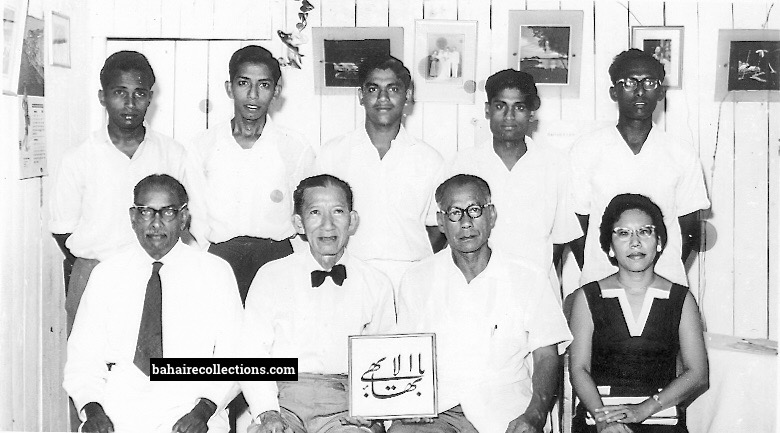
Local Spiritual Assembly of Seremban, 1961. Seated L-R: K. Rajah, Yankee Leong, Poh Eng Siew, Lily Ng. Standing L-R: Stevan, Nit Singam, S. Satanam, Annamalai, and R. Marriappan.
In 1962 the National Teaching Committee of the Federation of Malaya and Singapore appointed Lily Ng as state representative for Negeri Sembilan to coordinate teaching activities. In 1963, she was appointed to the Women Affairs Sub Committee under the National Teaching Committee to get more women roped in to serve the Cause. She was in the forefront of organising activities for women in Seremban area.
The year 1962 also witnessed some of the strong and veteran believers leaving Seremban as homefront pioneers or getting transfered to other localities. But Lily Ng remained in Seremban and handled the local affairs of the Faith.
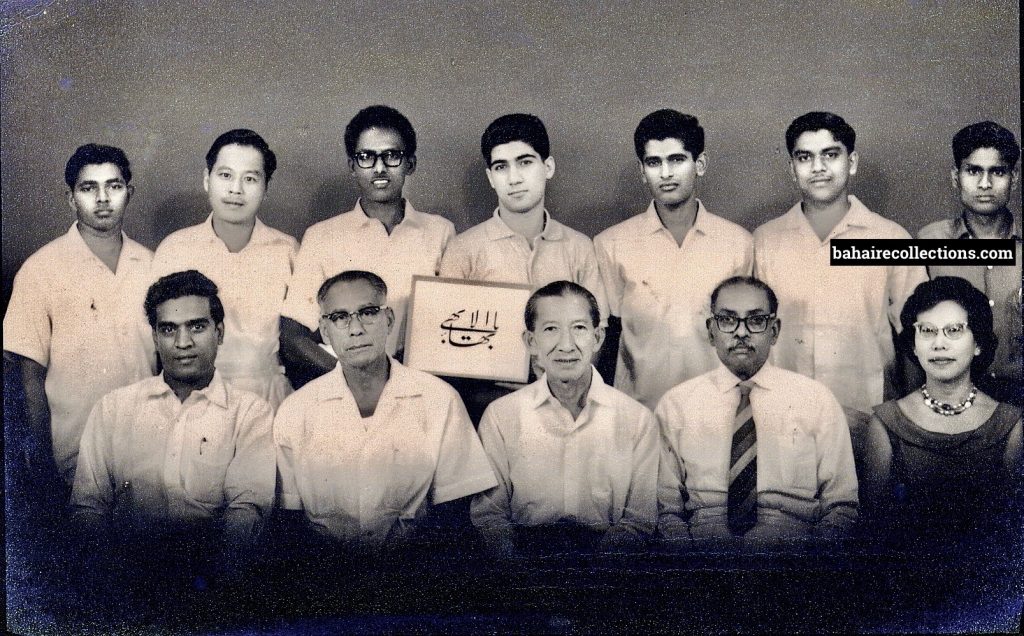
Group photo, January 1963 . Seated L-R: (Unknown) Poh Eng Siew, Yankee Leong, K. Rajah, Lily Ng. Standing L-R: A. Sabapathy, Lee Teck Seng, R. Mariappan, Bijan Bayzayee (Persian pioneer to Laos who passed through Malaya), Isaac DCruz, S. Satanam, Annamalai.

Seremban Bahá’í Centre, 1963. Sabapathy, Yankee Leong, Margaret Bluett, Noel Bluett, Lily Ng, (unknown). Margaret and Neol visited Seremban on their way to the First Bahá’í World Congress. (Photo credit: Margaret Bluett)
ESTATE TEACHING
Although an urban dweller, she rose up as one of the most active teachers of the Faith in the estates of Negeri Sembilan. In 1963 she used to provide translations for Mr. Yankee Leong in the various estates in Negeri Sembilan and soon herself got actively involved in undertaking teaching and deepening activities in estates around Rembau, Ulu Pedas and Jelebu towns as well as the Labu Estate, and Ribu Estate. In the absence of her own transport, she resorted to public transportation, especially buses to reach these places. Each time she went to the estates, she always had something to be given away as gifts, such as handkerchiefs for the adults and sweets and biscuits for the children. She became most loved and respected by the simple estate people. She had not the least trace of racial prejudice which was the cause of great attraction from the simple people. Her attachment to the simple estate Indians may explain why she was often clad in Indian sarees when attending some functions in her early days.
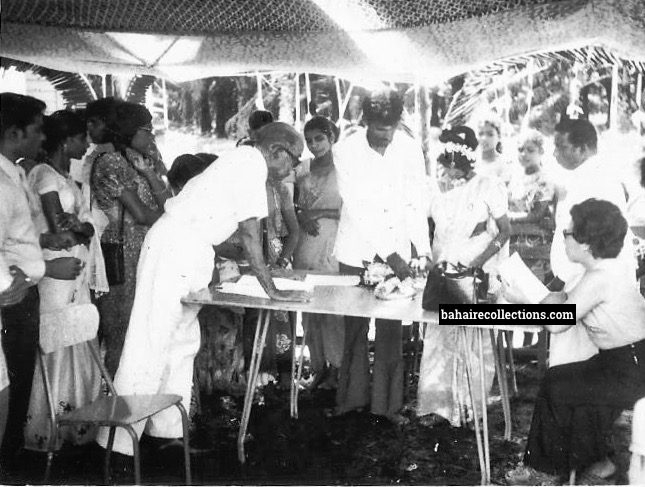
Bahá’í Marriage of Jeffery Bala in Ampar Tenang Estate in Sepang, conducted by the Bahá’ís of Seremban. At the extreme left is Mr. K. Rajah, and at the extreme right is Lily Ng.
INTO THE INTERIORS
In 1963 constant visits to Kampong Chang became a necessity with the key believer there having moved away from the Faith. On request by the National Teaching Committee of Malaya, Lily Ng then visited the village often to activate the aboriginal friends there. And it paid off handsomely. In November 1963 the believers of Kampong Chang built their own Bahá’í Centre. The men contributed an hour a day to go into the jungle and cut bamboo and rattan. The women plaited the atap for the roof and made the walls. No outside financial help was sought. This became the largest building in the village. The Asli believers in Kampong Chang held their first summer school in this newly build Bahá’í Centre, from December 20 to 22, 1963. It was Lily Ng who stayed with them and gave them every assistance, ranging from organising the summer school to cooking for a total of 80 participants of all ages, with the assistance of the Aboriginal women. Page 4 of the Bahá’í News magazine for the month of May 1964 published by the National Spiritual Assembly of the Bahá’ís of the USA says, “One of the successful activities of the summer school was the sharing of meals. It is not common for the Semai to eat together – a new tradition was established and a new sense of Bahá’í brotherhood was created. It was not easy to cook for eighty people on the small wood fire (left) at one side of the house. Much credit must go to Mrs. Lilly Ng who not only helped plan the meals but was instrumental in getting the many women to work together – and more important gave each woman a sense of contributing to the success of the school.”
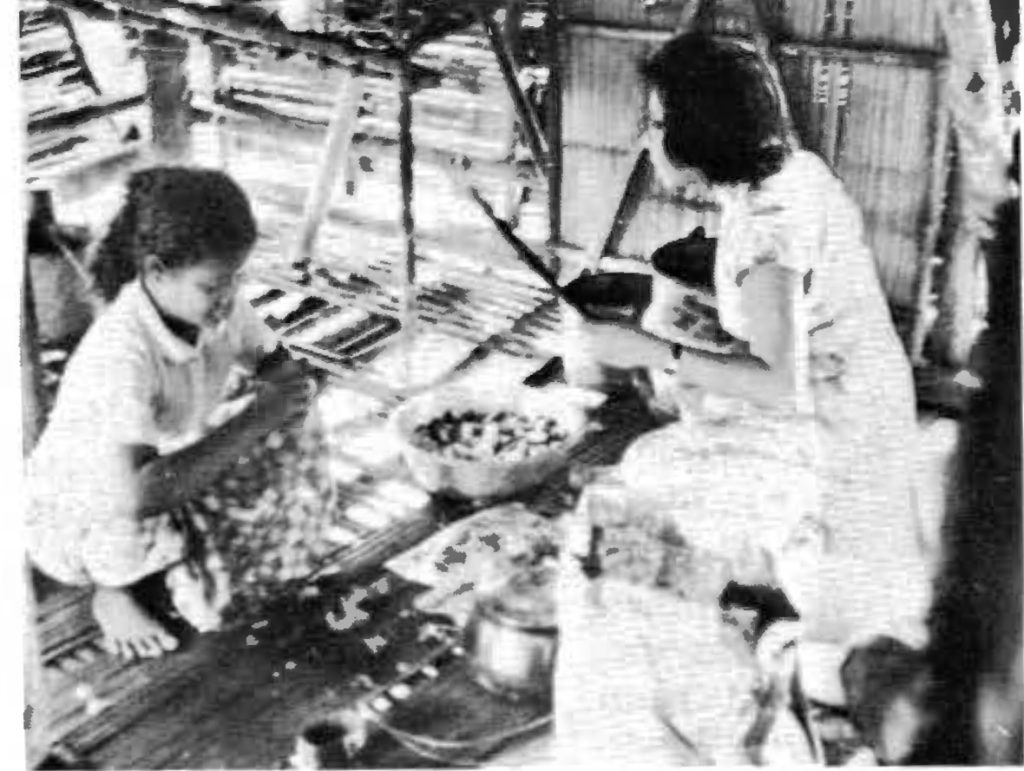
SERVED AT THE FIRST NATIONAL INSTITUTION
Lily Ng saw the birth of the first national institution of Malaysia in 1964. In 1963, the Regional Spiritual Assembly of South East Asia appointed a National Convention Committee with Lily Ng as one of its members. Mr. Inbum Chinniah of Jasin was elected as Chairman while Lily Ng was elected Secretary of this committee. This committee had to shoulder heavy responsibility in getting the first National Spiritual Assembly elected in 1964. Some of the stressful and strenuous matters were the preparing of sound logistics, updating of statistics, educating of all delegates on the nature and principle of Bahá’í administration. And the committee could not make any mistake in electing this first national spiritual assembly- an institution divinely ordained!

First National Convention. Seated L-R: Phung Woon Khing (translator), Leong Tat Chee (Convention Chairman) Harlan Lang (Convention Secretary) and , Lily Ng (Recording Secretary)
Mr. Leong Tat Chee from Malacca was elected as Chairman of the Convention, and Lily Ng the Recording Secretary. She recorded the entire proceedings of the first convention, covering verbatim recording of talks by the delegates and Amatu’l-Bahá Rúhíyyih Khánum, who represented the Supreme Body at this convention. Today the document forms an invaluable asset for our history.
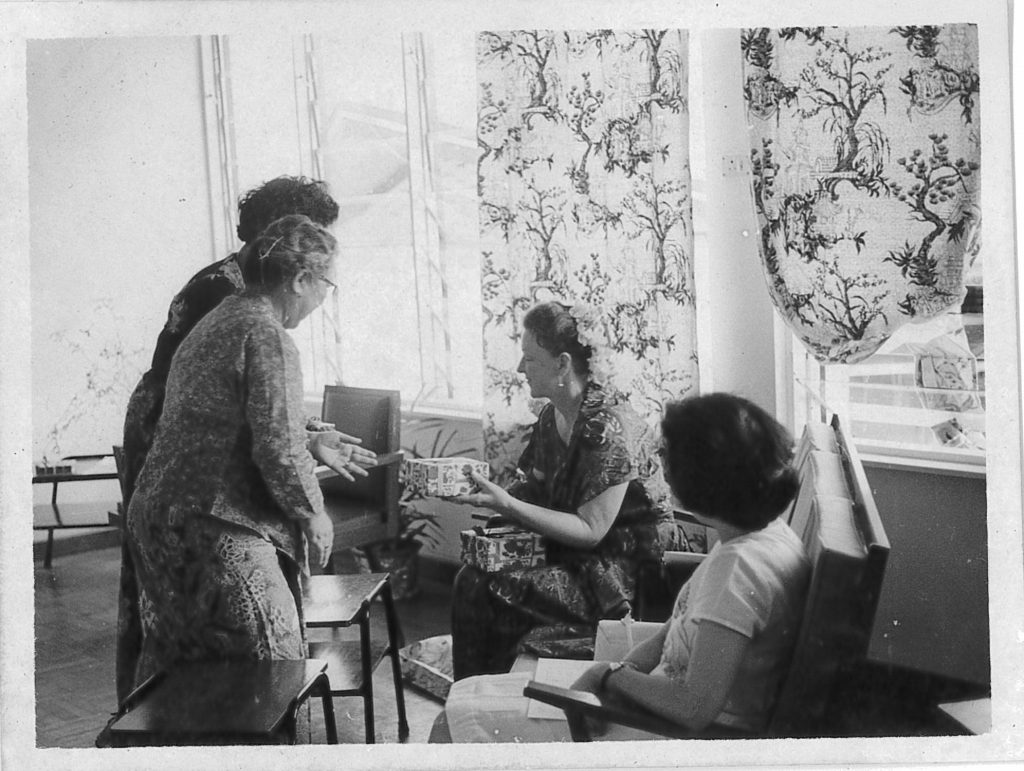
First National Convention. Lily Chinniah at the extreme left (partly hidden), presenting a gift to Amatu’l-Bahá. To the right of Lily is Mrs. George Lee. Seated at right is Lily Ng.
MORE RESPONSIBILITIES
In June 1965, the first issue of the Malaysian Bahá’í News Magazine was issued as the news organ of the National institution. Several regional correspondents were appointed to gather news and submit to Mrs. Shantha Sundram, the editor of the magazine. Lily Ng was appointed one of the regional correspondents Negeri Sembilan state, to gather and send over newsworthy material to be published. She carried out her duties diligently.
The National Teaching Committee of Malaya was appointed in 1964. When Lily was its secretary in 1967 she had to deal with a huge volume of letters from across the country. Yet she ably communicated with the communities and addressed their needs pertaining to teaching matters. She was praised for coordinating the teaching activities in Malaysia. In 1967 the National Spiritual Assembly formed the Women’s Committee and appointed, among others Lily Ng to serve as its member, one of their duties was to compile a list of Bahá’í women, correspond with them and activate them, and to initiate plans and activities for the women of this country. The goals included holding local conferences, paying visits to Bahá’í homes, conducting children’s classes, carrying out correspondences, conducting and attending deepening classes, and visiting the sick.
UNPRECEDENTED SACRIFICE
The National Convention of 1967 shall always go down in history. At this convention the meaning of contribution to the funds took a new dimension. When the call for funds was made, this was probably the first time that Bahá’ís started to contribute their jewellery, starting with Lily Ng and followed by Lily Chinniah. Lily Chinniah donated her diamond engagement ring that Inbum gave her as well as the pearl set her mother had given for her wedding. The spirit of sacrifice that prevailed at this Convention was marvellous.
A DYNAMIC LEADERSHIP
In the early 1960s when many veterans had left Seremban, Lily Ng took lead in raising the banner of the Faith in Seremban. She became an anchor in Seremban. Yankee Leong was all the time travelling. Satanam and Sabapathy had already left for Jelebu and Kuala Pilah respectively for home front pioneering. Mr. Vishnupatham had left for Sabah. From 1968 to January 1971 Mr. Isaac D’Cruz went for a degree course at University Malaya. Mr. K. Rajah was already too old to take up heavy responsibilities. Mr. Poh Eng Siew, a millionaire was a highly helpful personality for the Bahá’í Faith in many ways. As owner of a 1,000-acre rubber plantation he helped in providing transport for teaching activities and had donated generously for the best interests and needs of the Faith. Sadly he was no more in the picture owing to an understandable reason. Mr. Krishnan Kandasamy or “Postman Krishnan” was away in Brunei. Added with these Mr. C. Kanagaratnam of Jeram Padang Estate had just come into Seremban and brought into the Faith a new batch of believers like Mr. Bornoh Das, Mr. Seetharaman and Mr. Sri Krishnan who all needed to be nurtured. Mr. N. Nagendran had moved into Seremban from Kuala Pilah and was an asset to Seremban. Lily Ng organised Sunday gatherings at the Bahá’í Centre in which the youths would turn up for prayers and deepening. After lunch she would send these youths to different parts of Negeri Sembilan for teaching. She also gave the youth bus fares for teaching trips. She herself would lead a team. The main area of her focus was estate teaching. The estates that were covered by the few were New Seremban Estate, Perhentian Tinggi Estate, Sungei Gadut Estate, Ulu Pedas Estate, Chembong Estate, Kirby Estate, Batu Dua Sebelas Estate, Batu Hampar Estate, Pasla Estate, Labu Estate, Labu Cheviot Estate, Nilai Town, Kubang Estate, Jendiram Estate, Bute Estate, Kombok Estate, Trentang Estate, and Rantau Linggi Estate. These estates are no more in existence as they have given way to urban development. She also visited Rembau and Tampin towns.
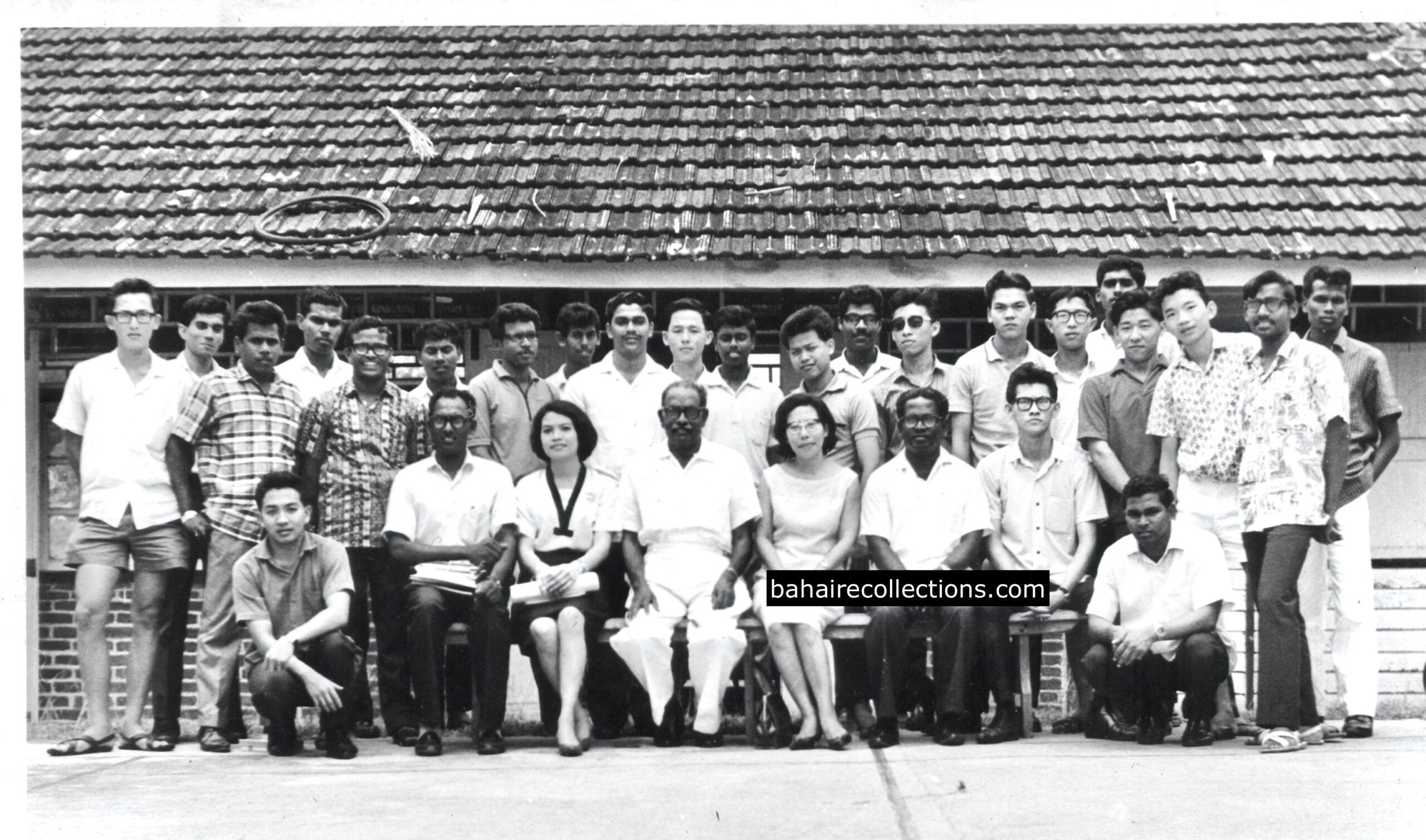 Bahá’í gathering in Kuala Pilah, February, 1966. Squatting at the extreme left is Jack Tan, and squatting at the extreme right is Sabapathy. Seated extreme left is R. Mariappan, at center is K. Rajah followed by Lily Ng and Steven Manoharan to his right. Jami Subramaniam is standing fifth from left, G. A. Naidu seventh from left. Satanam is standing in white right in the center. Nagendran is standing thirteenth from left.
Bahá’í gathering in Kuala Pilah, February, 1966. Squatting at the extreme left is Jack Tan, and squatting at the extreme right is Sabapathy. Seated extreme left is R. Mariappan, at center is K. Rajah followed by Lily Ng and Steven Manoharan to his right. Jami Subramaniam is standing fifth from left, G. A. Naidu seventh from left. Satanam is standing in white right in the center. Nagendran is standing thirteenth from left.
Lily Ng was the pillar of these teaching activities. At every meeting, she consistently emphasized the importance of teaching the Faith and achieving its goals. Tireless in her devotion, her thoughts were continually focused on the advancement of the Cause she seemed never to rest, driven solely by the desire to teach the Faith at all times. Through her teaching activities in the estates some of the finest gems were brought into the Faith. In 1966 she and Mr. Firaydun Mithaq of Laos brought Kuppusamy from the Kombok Estate into the Faith. Yankee Leong and Lily Ng who used to go to the Terentang Estate for teaching and brought Lean Beng Liew into the Faith. Kuppusamy pioneered to Sarawak and then to Sabah and had served as a member of the Spiritual Assembly of the Bahá’ís of East Malaysia and Brunei, and as Auxiliary Board member for Sarawak, while Beng Liew pioneered to Laos and was also the first Malaysian pioneer to the Solomon Islands and was elected to the National Spiritual Assembly of South West Pacific Ocean in 1968.
It is only too natural for one to wonder where Lily Ng drew the energy and had the time to carry out these manifold services for the Faith. She was the Secretary of the Local Spiritual Assembly, Secretary of the National Teaching Committee, and Secretary of the Area Teaching Committee of Negeri Sembilan was based in Seremban. The Area Teaching Committee was doing its best to stimulate teaching and consolidation work, and Lily Ng was constantly on the move visiting and encouraging other communities in the state. Satanam and Sabapathy who were away as home-front pioneers and Yankee Leong who would be dropping in from time to time simply marvelled on how Lily was able to take the lead and manage the affairs of the Cause almost single-handedly in Seremban. Lily was able to breathe when Isaac returned to Seremban in January 1971 after his studies. In 1971 the National Asli Teaching Committee was moved to Seremban as a base. Lily Ng was a member on that committee, along with Rama Naidu, Nagendran, Isaac d Cruz, G.A. Naidu, Yong Siew Kang, S. Satanam, Tan Hui Chuan and Lawrence Ng. The Asli believers were brought to the Seremban Bahá’í Centre for training and Lily Ng was one of those who helped out in running the course. The food for the participants was very lovingly prepared by her sister Pauline D’Cruz.
CHILDREN EDUCATION
When Lily Ng accepted the Faith in 1960 there were not many children in Seremban to start off children classes. Most of the believers in 1960 were still not married. In the middle of 1960s there were sufficient number of children to hold children classes. Whenever Yankee Leong was in Seremban he himself would gather children to conduct children classes. As he was always traveling the baton was passed on to Lily Ng who very ably organised the children classes.
There were some individuals in the then Malaya who had shown interest in the development of syllabus of study for the children classes. Lily Ng from Seremban took it on herself to work on the production of lessons for children class. She compiled the children class materials and sent them to different parts of the country every week. When Lily Ng was the Secretary of the National Teaching Committee in 1966, she wrote a significant and moving letter to Mr. Joseph Swaminathan of Kuala Lumpur in which she stressed the importance of education of children. Part of the letter dated 31 August 1966 reads:
“…The teaching of children is of importance because we will definitely get good Bahá’ís in the 2nd generation; so we must work for them now and hold classes so that they are trained to know and love the Faith. In the early days in Persia some of the first believers were smokers, drinkers etc, but they in their dreams could never believe that their children and grandchildren would spread far and wide and devote their lives for the Cause. So if we bring in the people please do not fear about the problems. Since it is the will of BAHA’U’LLAH and the Universal House of Justice, all problems will eventually be solved. We do our duty.”
Negeri Sembilan state had excellent children’s classes, initiated mainly by Lily Ng. In the Jerampadang Estate, 22 children were attending the children’s classes in 1968 which she supported in every way. In 1969 it was reported that Negeri Sembilan had the highest number of children attending children’s classes in the country. More than 150 children were attending children’s classes in 5 different centres. Lily Ng of the Women’s Committee had prepared the materials for the classes. At the First South East Asia Regional Youth conference held in December 1968, at the Malayan Teachers College a large exhibition was put. Under the supervision of Lily Ng, the children of Seremban had produced some hand written manuscripts to make the exhibition more interesting. Hand of the Cause of God Mr. Faizi was very impressed with the exhibition in general and the hand-written manuscripts in particular. She was one of the speakers at the first time Pre-Dek Institute held in South East Asia in the month of December 1972 in a bungalow in Penang. This was for those between the ages of 10 to 14 who had not signed their declaration cards.
SERVICES ABROAD
Lily Ng also left her indelible traces abroad. The National Spiritual Assembly of Singapore formed a Chinese Teaching Committee and sought assistance from the neighbouring national institutions with a large number of Chinese speaking believers to help them out in teaching the local Chinese population. Lily Ng arose and pioneered to Singapore from 1974 to 1977 with the aim of reaching out to the Chinese speaking population in the island country. When Mr. Kenneth Mark, member of the National Spiritual Assembly of Singapore attached to the Ministry of Foreign Affairs was posted to Indonesia in July 1974 a by-election was held and Lily Ng was elected to this august body and remained as member till 1977. She also served on the Singapore Council of Women’s Organisations while in Singapore.
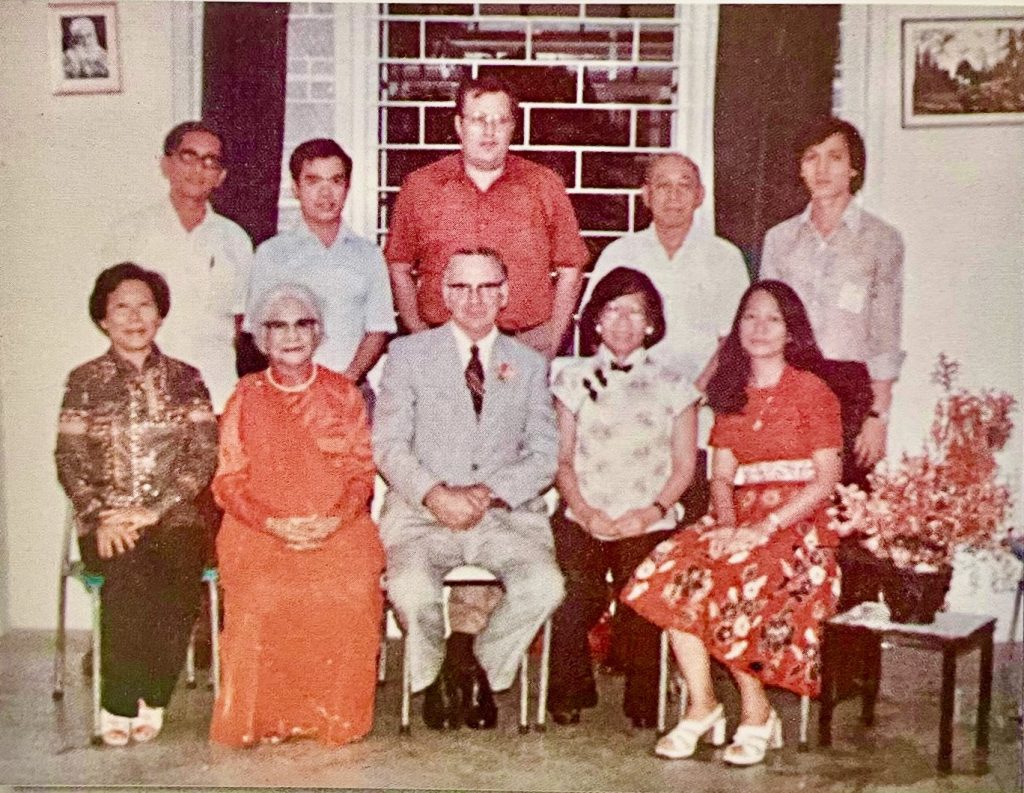
Hand of the Cause Mr. Collis Featherstone with members of the National Spiritual Assembly of Singapore in 1975. Seated L-R: Lily Ng, Shirin Fozdar, Collis Featherstone, Rose Ong, Lena Tan. Standing L-R: Freddy Tan, Foo Hong Tatt, Robin Maule, Teo Geok Leng, Leong Weng Fatt.
Lily Ng fulfilled Singapore’s pioneer goal to Hong Kong in 1978. On the way to Hong Kong she was in Taiwan for a short stint. In Hong Kong she lived on the Lamma Island which had a temple site for the island country purchased in 1975. There she served as an Auxiliary Board member effective in 1983. While in Lamma Island, Lily was loved by each and all. The youth would love to visit her on Lamma Island where she was staying and looking after the Lamma Villa. Lily was able to win over the local people, Bahá’ís inclusive, with her fluent Cantonese which she spoke with an accent. Daya Datwani in Hong Kong recalls that whenever her spirit was high, she would sing and dance and do skits. They also remember she was very generous and would serve meals to those who came to visit her. They further recollect that Lily Ng was very radiant and always displayed a warm disposition with a laughter that was contagious. There was a moment when her son Francis Ng and daughter Evelyn Ng came to visit her while she was serving in Hong Kong. Owing to visa restrictions Lily could not stay continuously had to exit Hong Kong every three months sometimes to Macau for re-entry. In Macau she was accompanied by Datwani sisters Meena, Lolita, Daya and occasionally brother Mohan and local youth Patrick and Victor Lui, Sabrina and Sylvia Lee daughters of Chester Lee. This teaching team would go to Lamma Island, Tai O and over Hong Kong.
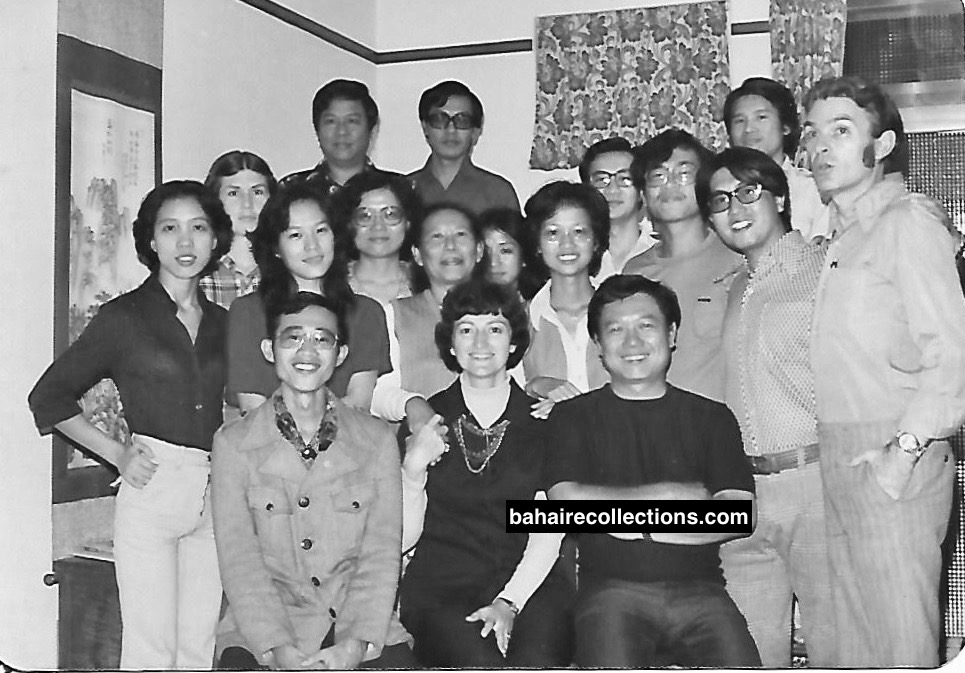
Gathering of 1978. Seated L-R: Chang Chee Phing, Ms. Gorski from the Bahá’í World Centre and Kit Yin Kiang. Lily Ng of Malaysia is at the back of Ms. Gorski.

Summer School Lamma Island 8 Aug 1978. Standing L-R: Dr. Ho, visitor, Ho Kwong Kit, Dany Ng, Daya, Mohan, Meena and Lolita Datwani, Sabrina Lee, Tsui Siu Hing, Sharon Bond carrying Mieko (child) and Julie Lee (child). Second Row: Marty Sze, Stephen Fong, Michael Bond, Lily Ng, Veamora, Lawrence Ip (unknown). Ground Row: Berouz Attar, Patrick Lui, Victor Lui, Jealei Bond, Chester Lee, Sunita Bond (child) Behnam Attar Sylvia Lee and Choy Choong Yew.
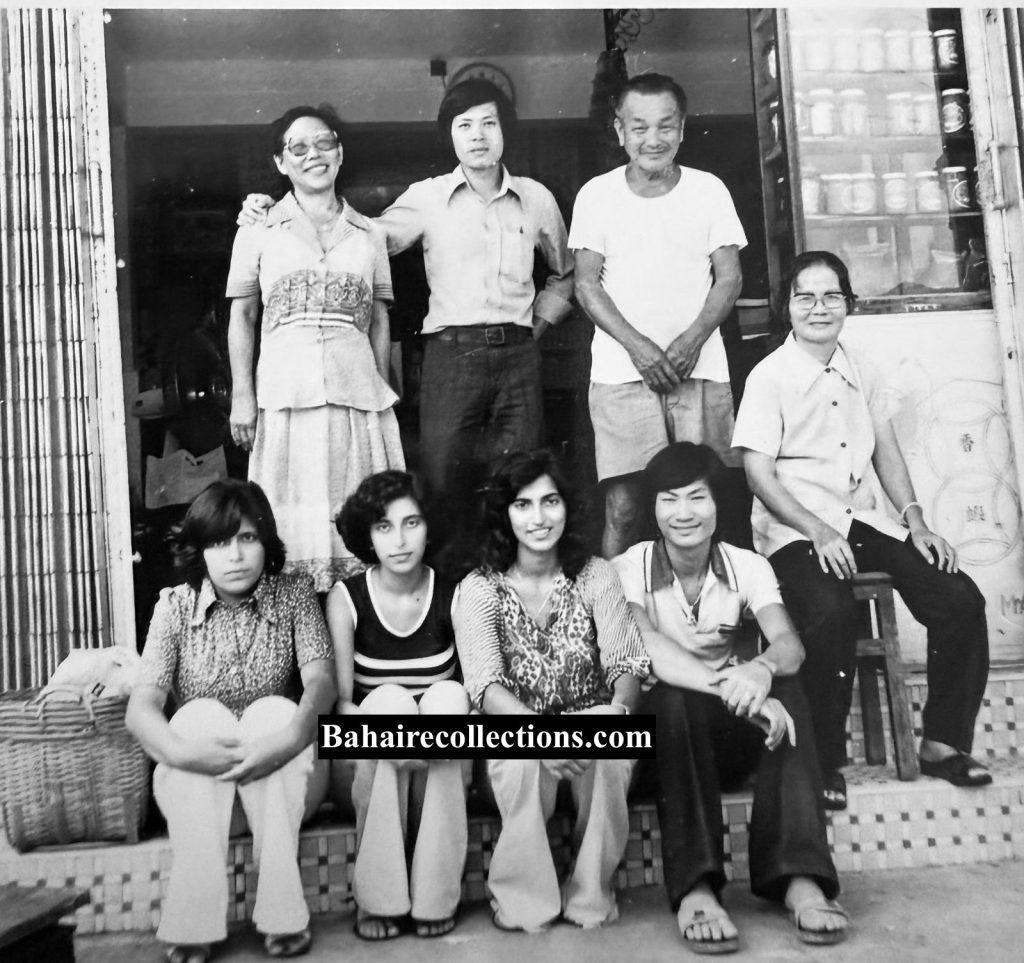
Tai O – Lantau Island, Hong Kong–teaching a shopkeeper and his wife. Standing L-R: Lily, Choy Choong Yew, shopkeeper. Seated: L-R: Daya, Lolita, Meena Datwani and Dany Ng.
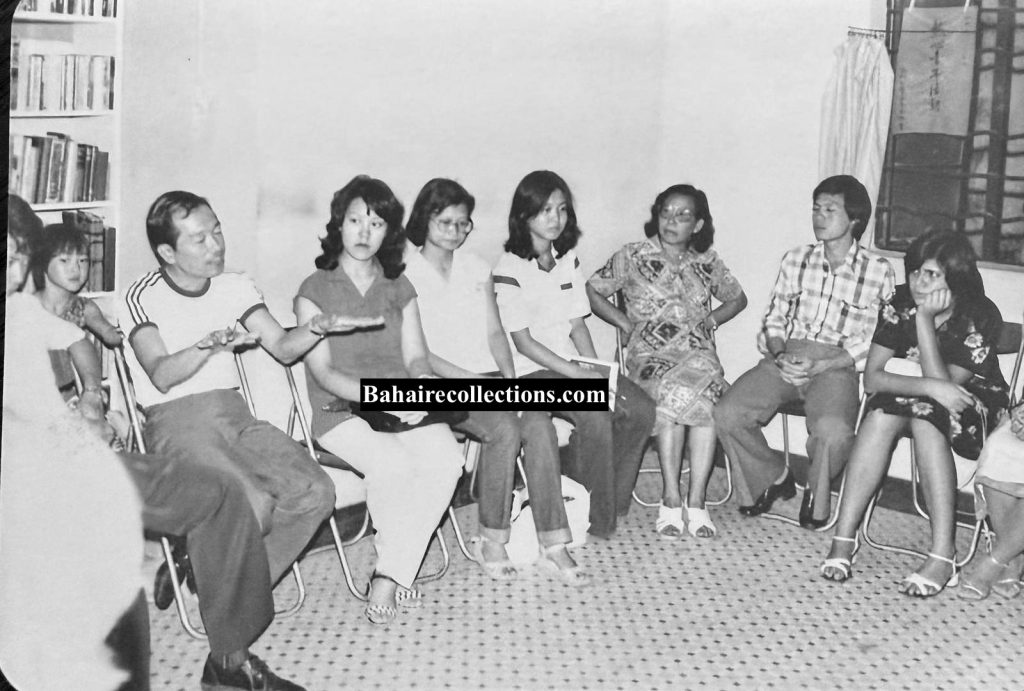
Fireside in Macau Bahá’í Centre in September 1978, with Chester Lee, Lily Ng, Choy Choong Yew and Daya Datwani.

Lily Ng visiting Datwani’s home Hong Kong in 1986. Standing L-R: Mohan Datwani, Helen Kaur (Ranee’s school friend), Daya Datwani, Choy Choong Yew, Ranee Sreedharan with daughters Nisha and Liva visiting from Malaysia. Seated L-R: Leung Choi Kee, Lily Ng, Mrs. Lachmi Datwani and Mr. Gianchand Datwani.
While in Hong Kong Lily Ng went on aggressive street teaching. In the next decade when new travel teachers went to the streets of Hong Kong and mentioned the word Bahá’í, some of them spontaneously recollected the name of Lily Ng who had given the Faith to them earlier. Having stayed in Hong Kong for seven years she was qualified to get her permanent residency. But she returned to Malaysia in 1984.
In late 1991, Lily Ng and Miss Thor Lay Kean of Kuala Lumpur community went travel-teaching to Calcutta, in India. They went to assist Mr. Phang Woon Khing of Alor Star, who was already travel teaching there. With the guidance from the National Chinese Teaching Committee of India based in Mumbai, they taught the Chinese speaking people in Calcutta who had settled there for decades.
From Calcutta, Lily Ng and Thor Lay Kean went over to Dhaka city, in Bangladesh. Mrs. Shaila Sumathi and her husband K .Vasu from Segamat, Malaysia were in Bangladesh as pioneers from 1988 to 1991. MR. Masoom Ul Huda, an Auxiliary Board member then and Shaila, took Lily NG and Thor Lay Kean on a few trips to a some villages for teaching as well as to visit some of them who had already accepted the Faith. For Shaila and Vasu and the other pioneers there, it was such a welcome surprise and joy to have Lily Ng and Thor Lay Kean tin their midst for about two weeks. The believers in the village, as well as the others who met her were clearly so happy with her services.

With some believers in a village in Bangladesh. Squatting L-R: Shaila Sumathi, Auxiliary Board member Masoom Ul Huda and Lily Ng. (Photo credit: Mr. Vasu)
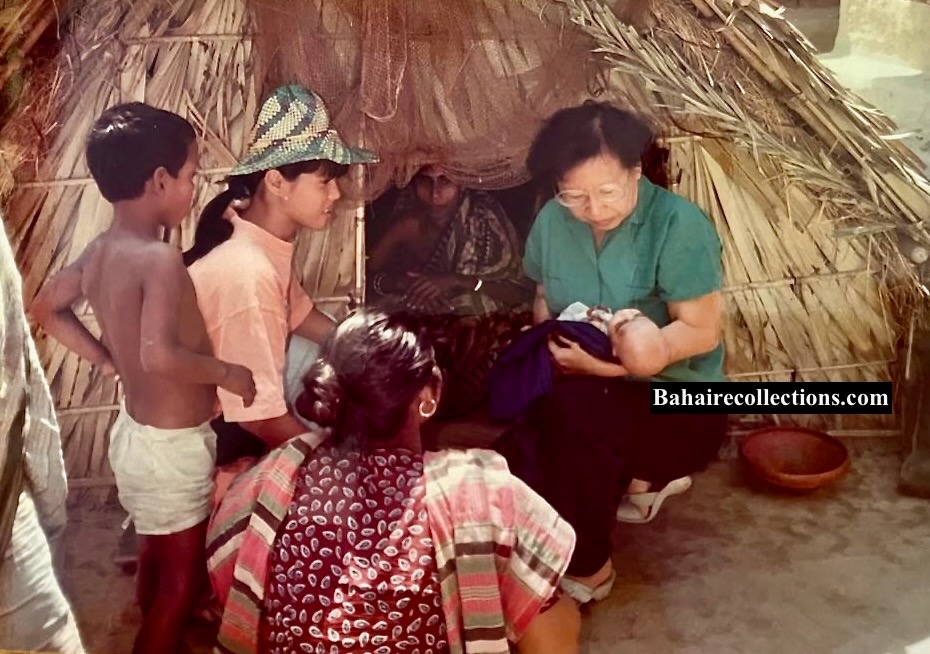
Lily Ng at right carrying a new born at a village hut, with Thor Lay Kean at left looking on. (Photo credit: Mr. Vasu)
A RARE SPIRITUAL BOND
Lily Ng loved all in the Seremban community but had a special spiritual bond with Mr. S. Satanam. Satanam had become a Bahá’í just a few months before the daughters of Yankee Leong. Satanam, however, was much younger than them, and the Yan sisters including Theresa Chee, Rose Ong, Pauline and Christie saw him as a member of their own family as Yankee Leong treated Satanam very much like his own son. Even Yankee Leong’s wife would especially invite Satanam to join the family during Chinese New Year celebrations. Lily Ng moreover recognised in Satanam a kindred spirit who had a similar passion for teaching the Faith. Satanam simply admired and tried to emulate the way Lily Ng would teach “unrestrained as a wind”. Very often Yankee Leong would entrust the two of them with responsibilities to go to a particular place to teach. Although in later years Satanam was away from Malaysia to serve the Cause as a pioneer in other countries, he and his wife Indra never failed to visit Lily on their return to their home in Seremban. She too looked forward to their visits. After Satanam’s untimely passing in 2005, Lily and Mrs. Satanam’s visits and care for each other continued to the end of Lily’s life.
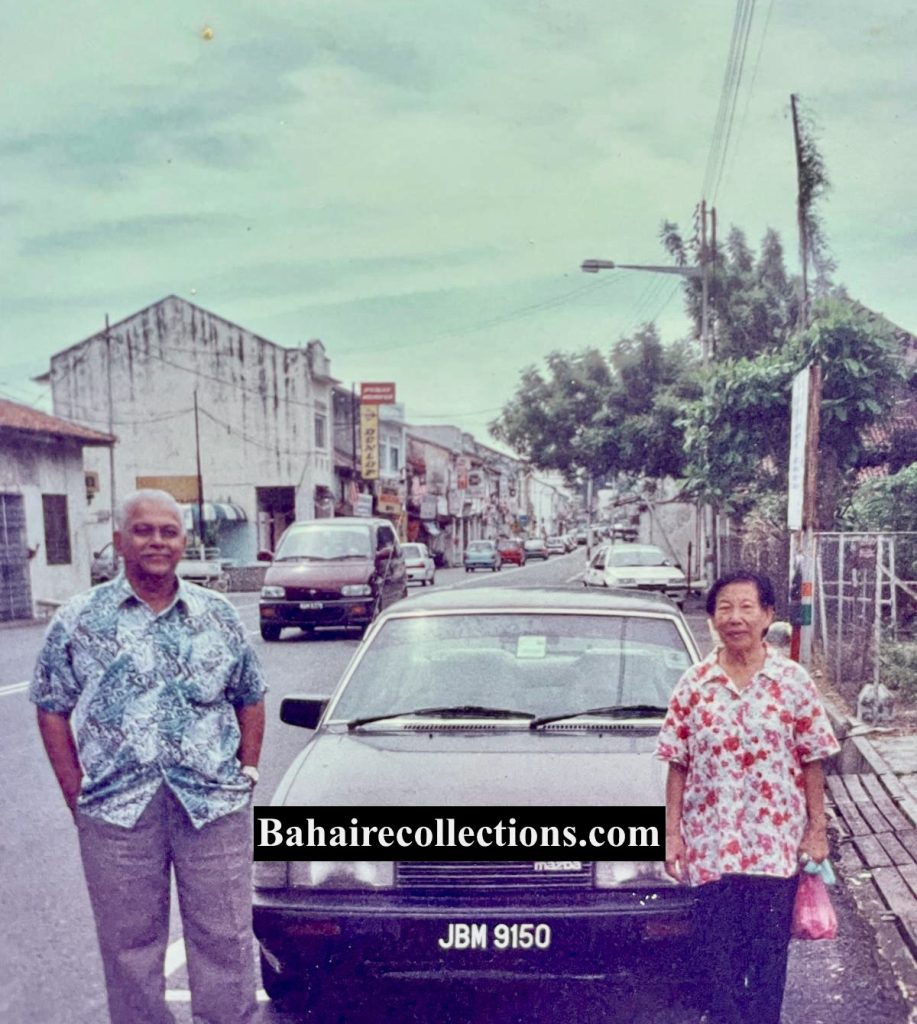
Satanam and Lily Ng on a teaching trip.
AN ELDERLY ADVICE
The greatness of the community of Seremban was clearly made manifest when they organised a birthday celebration at the Forest Heights Bahá’í Centre to honour Lily Ng when she attained the age of 90, in 2016. It was organised by her son Francis Ng, her adopted daughter Molly Ng Moi Chin and niece Melanie. This was as a mark of much respect for one who had been their spiritual mother, and guide for more than half a century. She was the oldest living believer in Seremban who had seen three generations born after she had accepted the Faith. An emotional Lily Ng had this to say, when asked to speak, “Today is my ninetieth birthday and my heart is really touched with the presence of so many people who have taken the trouble to come here. So, I would like to thank each of you present here. When I think of my life of 90 years, it has passed by with the twinkling of an eye. Before you can realise it, you are already very old. All of you present, you are still young. So, whatever you want to do you have to do when you still have your facilities and capabilities, like traveling or visiting some countries or doing something that you really like to do. Now I am ninety years old and I have lost my sense of capacity, my ability, and efficiency. Now I am not able to see well or hear properly. My legs are also not that strong to walk long distance. I can only walk for short distance. I wish each of you present here a very happy life. I hope your wishes will come through. I hope God will bless each one of you present. I thank you once again for being so kind of you to be present. I think every one of you has done something good to me and help me in life.”

Lily Ng still dynamic at her 90th birthday celebration.

Members of the Seremban Bahá’í Community at the 90th birthday celebrations of Lily Ng.
The members of the Seremban community never failed to invite Lily to their activities as they felt it an honour to have her in their midst. Lily too never failed to accept their invitations, as she always loved to be in the company of the believers.
EVENING OF HER LIFE
Towards the end of her life, she fell down a few times at her home. Once her head was injured from which she started to have dementia problems. Her adopted daughter Molly Ng Moi Chin moved in with Lily Ng just before Francis and family left for Macau on 19 September 2019. Molly was taking care of Lily Ng and the house and cooking for her. Several believers of Seremban visited her, sometimes bringing food prepared at home. Mr. G. Subramaniam or G. S. Maniam played the key role in visiting her daily and acted as her guardian, and withdrew her pension from her bank. She started to suffer from hearing ailment and almost lost her eye sight, coupled with old age-related complications. When her eldest daughter Evelyn Ng had passed away in the USA on 2 July 2024, this matter was not disclosed to Lily Ng on account of her frailty. Her son Francis Ng had settled in Macau with his family and was not in a position to come home. Lily Ng was lonely in her own home. More friends cheered her up by constant visits.

Friends visiting Lily Ng at her home in 2023. Seated L-R: Lily Ng, Rose Ong, Gim-Jin Lim, Chok-Kee Quah, Kim-Fook Yip, Kin-Min Hew, Kuang-Wang Koh, Siew-Kang Yong.
Despite her failing health, she would unfailingly enquire about the Bahá’í friends and ask what were the forthcoming Bahá’í activities whenever visitors came. Her conversation with Bahá’ís always centred on the Faith. Even at that condition she wanted the believers to drive her for Bahá’í activities, especially teaching trips for which she had an unquenchable thirst. By this time she was already quite blind and had lost her hearing ability as well. When she could not move freely, G. S. Maniam would visit her and read out loud the Feast letters and other messages from the national institution or the Supreme Body. She loved to be informed of happenings around. When the new National Haziratu’l-Quds was open for the believers on 17 June 2023, she expressed interest in visiting the spiritual edifice. In September that year Mr. G. S. Maniam and Mr. Mr. Ashvin Murali of Seremban drove her there. Although bound to a wheelchair, and having poor visibility, Lily Ng used her hands to feel the walls of the building, with those accompanying her explaining the details. She was overwhelmed with emotions.
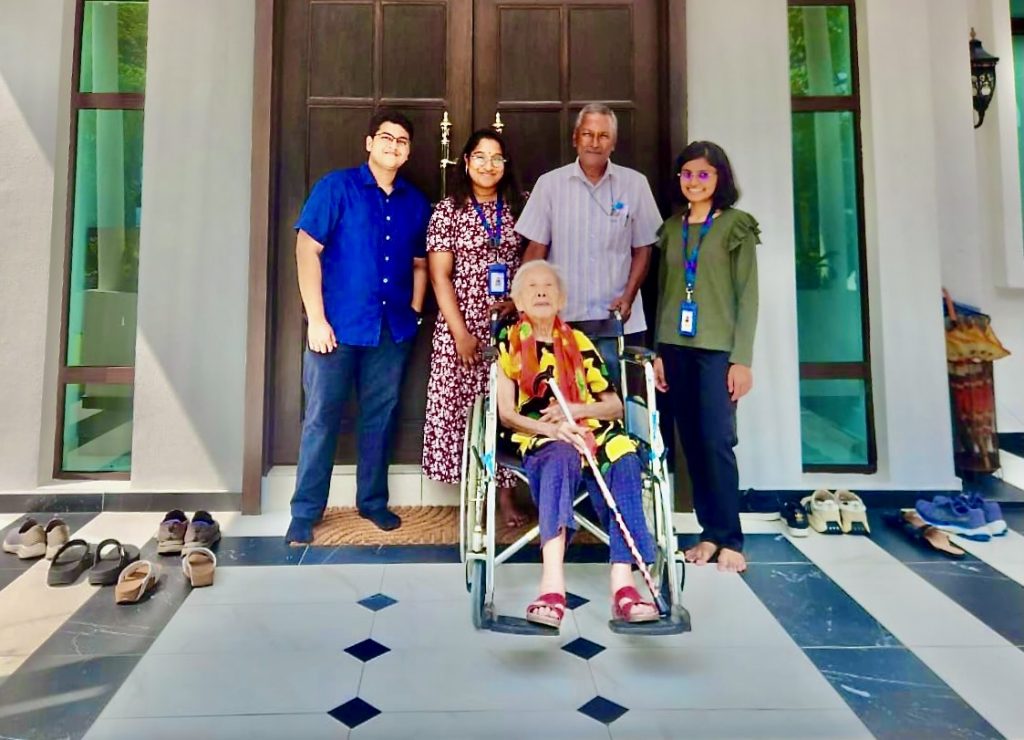
Visiting the new Haziratu’l-Quds in September 2019. L-R: Ashvin, Shukla Ramasamy, G. Subramaniam and Lavanya Kalaichelvan.
PEACEFUL PASSING
When her health deteriorated further, she was sent to the Happy Life Care Centre in Seremban on 1 September 2024. Several individual members of the community, especially G. S. Maniam visited her almost daily to attend to her needs. He had given his name as her Guardian at the Care Centre. Visitors saw Lily reciting the Tablet of Ahmad in full, oblivious to those around her. This was a very painful sight for the believers of Seremban who had seen her in the forefront of activities demonstrating such a dynamism. When her situation became critical, she was admitted into the Seremban Government Hospital. Then a telephone call came to G. S. Maniam her guardian saying that Lily Ng passed away very peacefully at 11:35 pm on 30 May, 2025. When she passed away her immediate family members were not with her and so the local believers rose to the occasion to have her body released, with G. S. Maniam signing the documents. When the news of her passing spread around the children of Theresa Chee and their spouses joined the local believers of Seremban and organised the most befitting funeral arrangements for her. By then Mrs. Tammy Tang Mei lok, wife of Francis Ng and Nigel Ng Keng Yin, their son had arrived from Macau. What a strange coincidence! On the early hours of 2 June, Mrs. Theresa Chee, eldest daughter of Yankee Leong passed away in Ipoh. Her family members who had arrived in Seremban and were making arragements for the burial handed over the the burial of Lily Ng to the local believers of Seremban and rushed to Ipoh to attend to the funeral and burial arrangements for Mrs. Theresa Chee. She was given the most befitting burial. Seldom have we witnessed two sisters accepting the Faith within a span of two months in the same year passing away within a gap of two days.
CONDOLENCE MESSAGES
On her passing three national institutions had sent messages of condolences. Part of the message from the National Spiritual Assembly of Malaysia says, “She was a bright light of example for the young and old on how one should deepen our knowledge in the Faith and have a thirst for it even when her physical faculties were weak and failing… Mrs. Lily Ng will be remembered as a stalwart of the Seremban Bahá’í community for decades and a beloved servant of Bahá’u’lláh. Her warm heart, deep humility, and passionate dedication to teaching will live on in the memories of all who were graced by her presence…”
Part of the message from the National Spiritual Assembly of Singapore says:
“Her quiet dedication, devotion for teaching the Faith, and readiness to contribute wherever she was calledremain an enduring inspiration to those who had the privilege of serving alongside her.”
Part of the message from the National Spiritual Assembly of the Bahá’ís of Hong Kong says,
“…as an Auxiliary Board member, she rallied and encouraged the friends throughout Hong Kong, particularly the youth. Throughout her time in Hong Kong, she was a passionate teacher of the Faith, spearheading numerous direct teaching efforts. She was particularly adept at drawing on the beauty and power of the arts, and her sincere love and concern for others had a profound effect on those who encountered her…..”
A few days after her passing the believers in Hong Hong organised a memorial service for her and placed accolades on her services.
A GREAT LEGACY
Many of the early believers and those in the current generation would consider Lily Ng as one of the finest gems gifted to the Seremban Bahá’í community, and by extension to the entire Malaysian Bahá’í community on account of her several rare virtues seldom found in any average person. She was very much an embodiment of love and concern to all those who crossed her life. Whenever someone was neglected by society, she would be the first to rush to his or her needs. She would go all out to sweeten the lives of those downtrodden. She ensured that those suffering without proper meals would be well fed. She always believed in bringing joy and happiness to others, given the radiant spirit that was always part of her nature. During moments of distress she always left everything in the Hands of the Blessed Beauty, as a prayerful person. Her generosity knew no bounds. Her home was a true Bahá’í home, as when one entered therein, they were made to feel very much at home and at ease. Anyone who entered her house would partake of whatever food was available, and when leaving her home, Lily would give something to be taken away, a habit she had till the last of her days. She was a balm to every wounded.
A GENUINE CARE FOR ALL
Lily Ng was always concerned of the spiritual health of believers. Whenever a believer was in an isolated situation Lily Ng would find her own way to bring the person into the mainstream of activities. She would go all out to ensure that nobody was lost out in their spiritual nourishment. Selvam, son of Satanam shares an incident that speaks volumes of this virtue of Lily Ng. Selvam says, “I was just over 12 years old when I arrived in Singapore for my secondary school studies at Raffles Institution. I had to learn to cope with a new education system that was different from the one I had been accustomed to in Seremban. I also had to adjust to hostel living. The initial few months were very tough, and regrettably during the first few months of my stay in Singapore I was unable to attend Nineteen Day Feasts and Holy Day observances… Late one afternoon as I returned to the hostel, there waiting for me were dear Aunty Lily, Aunty Molly Sreenivasan and Aunty Christine Lee. They were the first Bahá’ís I met in Singapore. They were like three angels who showered a then 12-year-old homesick child with the warmest Bahá’í love and concern. A few days later, I was in my classroom in school, when unexpectedly during school hours Aunty Lily turned up at my school with a big bag of food and snacks for me to bring back to the hostel. More significantly, she spent time with me to gently assure me of the power of divine assistance contained in Bahá’u’lláh’s prayers. The visits left me spiritually refreshed and uplifted. In hindsight, she was the catalyst for me to connect with the Singapore Bahá’í community and embark on a wonderful journey of participation in the amazing endeavours of the community. Her absolute faith in the power of prayers was her gift to those like me that she visited and fortified through her wonderful generosity of spirit”. Selvam was not the only believer to have received such care and love from Lily Ng.”
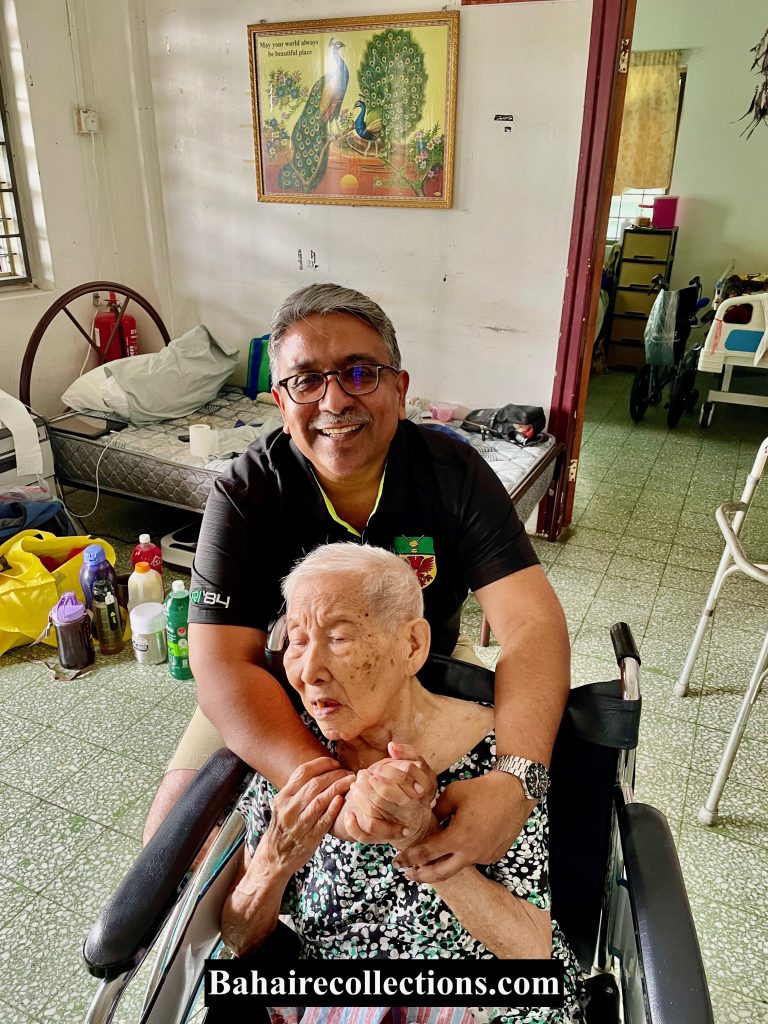
Selvam Satanam with Lily Ng at the Happy Life Care Centre in January 2025. (Photo credit: Mr. Yew Chee Keong)
A TOWERING FIGURE
Lily Ng was a strong supporter of the institutions and their activities. She was very firm in the Covenant. Although a soft person in nature, she never hesitated to be a roaring lioness in defending the Faith. For the past 65 years Lily Ng walked as towering figure in the Seremban community. There could be nobody who was not touched by her relentless service to the Cause, boundless love for Bahá’u’lláh and firmness in the Covenant. Lily Ng, and her sisters Theresa Chee and Rose Ong were Auxiliary Board members at different times. Rose Ong and Lily Ng were on the National Spiritual Assembly of Singapore. Rose Ong was also an Auxiliary Board member and later served on the Continental Board for Asia. Their illustrious and saint-like father Yankee Leong the first Secretary of the National Spiritual Assembly in 1964 and was appointed Auxiliary Board member in 1965 and then on the Continental Board for South East Asia. They all won the love and admiration of the higher institutions. Thus, ended an outstanding life that was well lived to bring gladness to the heart of his Creator through constant and continuous service for the Cause of Bahá’u’lláh. That towering figure is now no more with us. Lily Ng occupies a special place in the history of the Faith. With her passing, a vacuum has been created that will not be filled for ages to come.
Far great have been the attainments and unforgettable the services of this humble servant, carried out quietly and most sincerely for the glorious Cause of Bahá’u’lláh which she considered the very meaning of her existence. The record of her outstanding, magnificent memorable and imperishable services which have been of a unique nature are recalled with great pride. The departure of Lily Ng from our midst certainly throws a shadow of gloom upon many of us who have moved closely with her. Ours is the duty to arise and redouble our efforts in order to carry on the spirit he has left behind in the field of serving the Cause. Ours is also the duty to pray for her pure and precious soul that deserves all the full and rich bounties of Bahá’u’lláh.
A. Manisegaran
30 June 2025
SOURCE:
- A. Manisegaran, Jewel Among Nations – An account of the early days of the Bahá’í Faith in West Malaysia, Splendour Publications (2003)
- A Manisegaran, Leong Tat Chee – A Sincere Promoter of The Cause, Bahá’í Publishing Trust of Malaysia (2017)
3. Bahá’í News magazine for the month of May 1964 published by the National Spiritual Assembly of the Bahá’ís of America.
4. Author’s conversation with Mrs. Lily in 2002
Copyright©bahairecollections.com
You may leave your comments at: info@bahairecollections.com
Readers may wish to read the story of Lily Ng’s elder sister Madam Theresa Chee: